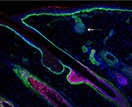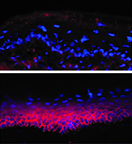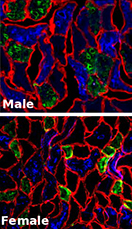SPOTLIGHT
Letter from Dr. Stephen I. Katz: Research, Outreach and Training in the NIAMS Intramural Program
Dear Colleagues,
At the January meeting of the National Arthritis and Musculoskeletal and Skin Diseases Advisory Council, we received an update from NIAMS Scientific Director John J. O’Shea, M.D., on the outstanding research being conducted through the NIAMS Intramural Research Program (IRP). The IRP is an important investment by the NIAMS, representing approximately 10 percent of our total NIAMS budget. Dr. O’Shea and NIAMS Clinical Director Richard Siegel, M.D., Ph.D., lead the program composed of over 30 basic science and clinical faculty and more than 100 trainees. The work of the NIAMS IRP spans the range of basic, translational, clinical and epidemiological studies. Our scientists and clinicians are doing ground-breaking research, and utilizing innovative tools and partnerships to further the National Institutes of Health (NIH) and the NIAMS mission.
Image: Stephen I. Katz, M.D., Ph.D.
NEWS
Updated NIAMS 2017 Funding Plan Now Available
The NIAMS is currently operating under a Continuing Resolution through April 28, 2017. The interim funding plan for research and training grants represents the most current information available.
Engineered T Cells Alleviate Autoimmune Skin Disease in Mice
A new study, funded in part by the NIAMS, has shown that engineered T cells can destroy antibody-producing cells that underlie a rare autoimmune disorder of the skin. The findings offer a new strategy for treating the disease, pemphigus vulgaris, and possibly certain other autoimmune conditions as well.
Image: Disease-causing antibody (red) levels are lessened by treatment with engineered T cells (top panel) compared to controls (bottom panel) in mucous membrane samples taken from mice with a form of pemphigus vulgaris. Photo credit: Aimee S. Payne, M.D., Ph.D., and Michael C. Milone, M.D., Ph.D., University of Pennsylvania School of Medicine.
Sex-Differences in Achilles Tendon Properties May Explain Why Ruptures Occur More Often in Men
A new study in rats, funded in part by the NIAMS, has revealed differences between males and females in the physical properties of the Achilles tendon. The results may explain why the incidence of ruptures is about five times higher in men than women. A detailed analysis of the characteristics of the Achilles tendon may lead to insights on how to avoid debilitating tears and possibly to new clinical approaches for repairing tendons.
Image: Calf muscle fibers (outlined in red) of male rats are, on average, larger than in females, likely placing increased strain on the Achilles tendon and rendering it more vulnerable to injury.
Photo credit: Louis J. Soslowsky, Ph.D., University of Pennsylvania School of Medicine.
NIH Director’s Blog: Snapshots of Life—An Elegant Design
Dr. Collins highlights research supported by the NIAMS in this recent Director’s Blog. This scanning electron microscopy image of the connective tissue that surrounds muscle cells is “one of the amazing scientific images that captured top honors in FASEB’s latest competition.”
Image: The photo is courtesy of Thomas Roberts, Ph.D., and David Sleboda of Brown University.
All of Us Research Program Announces Funding Opportunity for Community Partners
The NIH has announced a new opportunity for organizations interested in helping engage volunteers in the All of Us Research Program, part of the Precision Medicine Initiative. This funding opportunity, open to national and regional organizations, as well as local community groups, will support activities to promote enrollment and retention in the All of Us Research Program across diverse communities.
Partnering on Pain Research: NIH, DoD and VA Announce Pain Management Collaboratory Funding Initiative
Eve Reider, Ph.D., program director in the Clinical Research Branch at the National Center for Complementary and Integrative Health (NCCIH), highlights the goals of a jointly supported initiative by the NIH, the Department of Defense (DoD) and the U.S. Department of Veterans Affairs (VA) to develop the capacity to implement cost-effective, large-scale clinical research in military and veteran health care delivery organizations. The focus is on nonpharmacologic approaches to the management of pain and comorbid conditions.
FDA Encourages More Participation, Diversity in Clinical Trials
Few people actually sign up for and participate in clinical trials, and those who doparticipate don’t always represent the U.S. population. Participation is especially low for certain populations, including adults age 75 or older and people from certain racial and ethnic groups. That’s why the Food and Drug Administration (FDA) is encouraging more patients to participate in clinical trials, especially people of different ages, races, ethnic groups and genders.
Final Rule Enhances Protections for Research Participants, Modernizes Oversight System: Significant Changes Made in Response to Public Comments
The U.S. Department of Health and Human Services and 15 other federal agencies issued a final rule to update regulations that safeguard individuals who participate in research. Most provisions in the new rule will go into effect in 2018.
RESOURCES
Spotlight on Scientific Imagery: Hair Follicles and Sweat Glands

NIAMS-funded researchers found that two opposing signaling pathways determine the formation of hairs and sweat glands. In developing human (embryonic) skin, hair follicles (pink) form first and sweat glands (arrow) emerge later. The study may help researchers improve skin grafts for burn victims and persons with some genetic disorders.
Image: The photo is courtesy of Catherine Lu, Ph.D., and Elaine Fuchs, Ph.D., Rockefeller University.
NIH News in Health: Scleroderma Affects Skin and More
Scleroderma is a group of diseases that affect the body’s connective tissue, which supports the skin and internal organs. Skin, blood vessels or other tissues may become hard or thick. Swelling or pain may arise in muscles and joints. Scleroderma can occur in people of all ages, races and ethnic groups. For unknown reasons, it’s more common in women than men.
NIH Office of Dietary Supplements Fact Sheets
The NIH Office of Dietary Supplements continues to expand its library of science-based fact sheets with the Omega-3 Fatty Acids Fact Sheet for Health Professionals. A consumer version is being prepared in both English and Spanish.
Is It Really ‘FDA Approved’?
Maybe you saw those words on a company’s website or in a commercial promoting a new product or treatment. Some marketers may say their products are “FDA approved,” but how can you know for sure what the U.S. FDA approves?
EVENTS
February NIAMS Advisory Council Meeting
The January 25 NIAMS Advisory Council archived videocast is now available in the Past Events section of the NIH Videocasting website.

Rare Disease Day at NIH
Monday, February 27, 2017
8:30 a.m. to 4:00 p.m.
Location: NIH Campus, Masur Auditorium (Building 10)
Cost: Free
Registration is here.
Available by videocast.
NIH Wednesday Afternoon Lecture Series
The NIH’s Wednesday Afternoon Lecture Series offers weekly lectures every Wednesday at 3 p.m. in Masur Auditorium, Building 10, NIH Campus. Renowned scientists from around the globe present research on a variety of topics. The lectures are Continuing Medical Education-certified, open to the public and available live via webcast.
Upcoming Lecture:
March 1, 2017
Angela Christiano, Ph.D., Columbia University Medical Center
“JAK Be Nimble: New Drug Targets for Hair Loss Disorders”
NIH Science Lectures and Events Available via Internet
The NIH hosts a number of science seminars and events that are available online through real-time streaming video (videocast). The NIH calendar notes these videocast events with a video icon ![]() .
.
Funding Announcements
If you would like information about funding opportunities, please view the NIH Guide for Grants and Contracts, the primary source for information about NIH funding opportunities. You can also request a weekly Table of Contents from the NIH Guide. In addition, the NIAMS website provides comprehensive information on NIAMS-related grants and processes.







